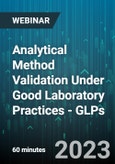If you do any work that will be reported to the US Food and Drug Administration (FDA), Environmental Protection Agency (EPA), or Occupational Safety and Health Administration (OSHA), your work must be done under GLP.
All methods must be validated, the proof that they do what is claimed. Common criteria are accuracy, precision, linearity, range, and several more.
This webinar will discuss the best practices of analytical method validation, including components of a validation, how to include critical reagents comparison, selectivity experiments, assessment of stability, importance of communication between the development and the validation labs and accuracy of transfer documents (SOPs).
Participants will understand - Is validation a regulated activity? When to pull the trigger for validation? Importance of suitability testing.
This analytical method validation webinar will provide practical tips on how to validate an analytical method under the GLP requirements. It is recommended for laboratories that are under, or want to be under, Good Laboratory Practices (GLP).
All methods must be validated, the proof that they do what is claimed. Common criteria are accuracy, precision, linearity, range, and several more.
This webinar will discuss the best practices of analytical method validation, including components of a validation, how to include critical reagents comparison, selectivity experiments, assessment of stability, importance of communication between the development and the validation labs and accuracy of transfer documents (SOPs).
Participants will understand - Is validation a regulated activity? When to pull the trigger for validation? Importance of suitability testing.
Why you should Attend:
Any laboratory that supports products for sale or use in the United States must follow Good Laboratory Practices (GLP), a comprehensive system that guarantees validity of results. If you work in pharmaceuticals, chemicals and petrochemicals, and environmental analyses then you are mandated to be following GLP. One of the major tasks in GLP is validation of an analytical method. The new pharmaceuticals are very often completely new compounds, structures never studied before by chemists. Their properties - such as solubilities and acid-base nature, are unknown. Synthetic reactions may make many similar types of molecules, including structural and optical isomers. The methodologies that mean US Food and Drug Administration compliance with GLP require a separation to be able to separate and identify all major, minor, and trace components. It is no longer just determining a purity of the main component. Each minor contaminant or degradation product is also important in GLP.This analytical method validation webinar will provide practical tips on how to validate an analytical method under the GLP requirements. It is recommended for laboratories that are under, or want to be under, Good Laboratory Practices (GLP).
Areas Covered in the Session:
- Method Validation
- The Criteria for a Method
- Statistical Requirements
- Maintaining Compliance
Speaker
John C. Fetzer has had over 30 year experience in HPLC methods development. He has authored or co-authored over 50 peer-reviewed papers onl iquid chromatography, has served on the editorial advisory boards of the Journal of Chromatography, Analytical Chemistry, and Analytical and Bioanalytical Chemistry.Who Should Attend
- Analysts
- Lab Supervisors and Managers
- QA Managers and Personnel
- Consultants
- Validation Specialists
- Chemists








